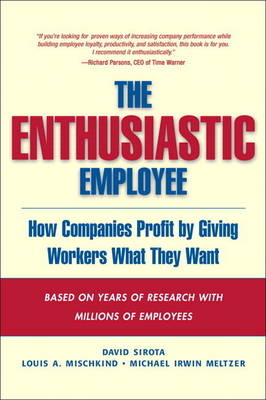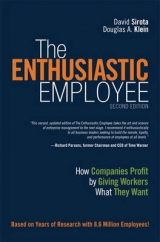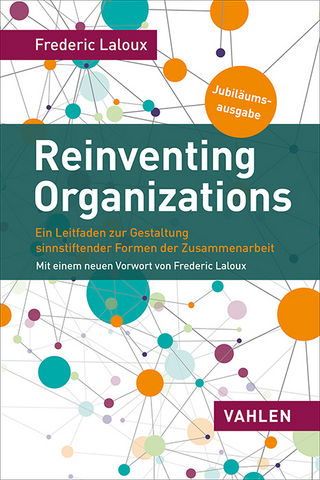
The Enthusiastic Employee
Financial Times Prentice Hall (Verlag)
978-0-13-714870-7 (ISBN)
- Titel erscheint in neuer Auflage
- Artikel merken
David Sirota is founder and Chairman Emeritus of Sirota Consulting, a firm with a national reputation for improving performance by systematically measuring and managing employee, customer, and community relationships. He previously served as IBM director of behavioral science research and application. Sirota has taught management at Cornell, Yale, MIT, and Wharton, and was a study director at the University of Michigan's Institute of Social Research. His work has been featured in Fortune and The New York Times. He holds a doctorate in social psychology from the University of Michigan. Louis A. Mischkind has been involved with organizational effectiveness–research and practical application–for over 35 years. Prior to joining Sirota Consulting, he was Program Director of Executive Development at IBM, Advisor on Human Resources to the President of IBM's General Products Division, and in charge of opinion surveys and management assessment for IBM's technical community. He has taught courses in social and organizational psychology at New York University and holds a master's degree in experimental psychology from Columbia University and a Ph.D. in organizational psychology from New York University. Michael Irwin Meltzer joined Sirota Consulting full-time in 2001 as Managing Director, after serving as its General Counsel for 20 years. He has advised businesses ranging from financial consultancies and real estate developers to sales, distribution, and construction organizations. He has also served as an Adjunct Assistant Professor at Pace University, teaching business organizations, real-estate law, and trusts and estates. He holds a J.D. from Brooklyn Law School. © Copyright Pearson Education. All rights reserved.
Acknowledgments.
About the Authors.
Introduction.
I. WORKER MOTIVATION, MORALE, AND PERFORMANCE.
1. What Workers Want—The Big Picture.
Blame It on the Young
What People Actually Say About Work
Three Factors
The Evidence
How the Three Factors Work in Combination
Individual Differences
2. Employee Enthusiasm and Business Success.
Making the Connection
Tell Us in Your Own Words
A Few Leading Organizations
Enthusiasm and Business Performance
Building the People Performance Model
II. ENTHUSIASTIC WORKFORCES, MOTIVATED BY FAIR TREATMENT.
3. Job Security.
Justice and Job Security
Best Policies and Practices
4. Compensation.
Money as Seen by Workers
Money as Seen by Employers
The Level of Pay
Pay for Performance
Strategies for Effective Compensation
5. Respect.
The Heart of Respect
Humiliating Treatment
Indifferent Treatment
The Specifics of Respectful Treatment
Physical Working Conditions
Status Distinctions
Job Autonomy
Constrained Communication
Day-to-Day Courtesies
III. ENTHUSIASTIC WORKFORCES, MOTIVATED BY ACHIEVEMENT.
6. Organization Purpose and Principles.
Elements of Company Pride
Company Ethics and Business Results
Ethics in the Treatment of Employees
Getting Practical: Translating Words into Deeds
7. Job Enablement.
Ah, Bureaucracy! The Evil That Just Won’t Go Away
A Management Style That Works
Layers of Management
The Benefits of Self-Managed Teams
8. Job Challenge.
Is This an Aberration, Are Workers Delusional, or Are They Lying?
Given a Choice, Few People Volunteer to Fail
Push and Pull Forces
9. Feedback, Recognition, and Reward.
Do Workers Get the Feedback They Need?
Guidance: Cognitive Feedback
A Short Course on Giving Guidance
Evaluation, Recognition, and Reward
Promoting From Within
Dealing with Unsatisfactory Performance
Feedback Sets Priorities
IV. ENTHUSIASTIC WORKFORCES, MOTIVATED BY CAMARADERIE.
10. Teamwork.
A Look Back
Are We Doing Better Now?
Socializing While Working
The Negative Effect of Uncooperative Co-Workers
Contentious Workgroups Are a Drag
Building Partnership
A Short Course on Effective Partnership Workshops
V. BRINGING IT ALL TOGETHER: THE TOTAL ORGANIZATION CULTURE—AND HOW TO CHANGE IT.
11. The Chapternership Organization.
Partnership and Its Alternatives
Application to Other Constituencies
12. Translating Chapternership Theory into Chapternership Practice.
It Starts at the Top
The Action Process
VI. APPENDICES.
Appendix A. Survey Administration and Population Composition.
Appendix B. Reliability and Validity of the Data.
Appendix C. Job Satisfaction: Demographic, Occupational, and Regional Breaks.
Appendix D. Comparisons with Other Norms.
Appendix E. The Readiness Questionnaire.
Endnotes.
Index.
| Erscheint lt. Verlag | 13.5.2008 |
|---|---|
| Verlagsort | Upper Saddle River |
| Sprache | englisch |
| Maße | 152 x 229 mm |
| Gewicht | 544 g |
| Themenwelt | Wirtschaft ► Betriebswirtschaft / Management ► Planung / Organisation |
| ISBN-10 | 0-13-714870-4 / 0137148704 |
| ISBN-13 | 978-0-13-714870-7 / 9780137148707 |
| Zustand | Neuware |
| Haben Sie eine Frage zum Produkt? |
aus dem Bereich



